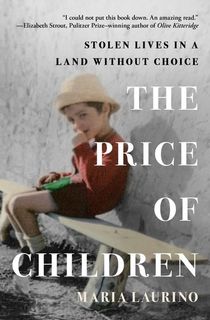In the 20 years between 1950 and 1970, nearly 4,000 Italian children were sent to the United States for adoption into Catholic homes through a partnership between the Vatican and the American Catholic Church.
Due to stigma around unwed motherhood and a culture of shaming women believed to have engaged in sin, many young mothers were lied to, deceived, given forms they didn’t understand, or even told their babies had died in order to supply this international adoption chain and rid the country of “illegitimate” children.
For the first time, Maria Laurino presents the buried stories of the children and mothers impacted, tricked, and torn apart by this widespread scandal condoned by the highest levels of the Catholic church. Laurino digs up the archival correspondence between the priests who ran the program and those who allowed it to be run.
The Price of Children brings a modicum of justice to the many, many lives affected by this immense wrongdoing. It also offers a chilling lesson in the dangers of a church or government being granted control over a woman’s life and motherhood, a lesson that is all too relevant today.
Read this excerpt from the first chapter of The Price of Children below—then purchase your own copy of the book to keep reading!
1 -
Turin, 1963
The handsome city that greeted Francesca from the train station, with its elegant arched porticoes and wide boulevards humming with prosperity, should have awakened something within the pretty, dark-haired twenty-three-year-old arriving from a small provincial town in Southern Italy. At another moment in Francesca’s life, the Po River would have beckoned her to wander along its edge as it glittered golden in the midday sun. In another time, Francesca would have entered one of the city’s famous centuries-old cafés replete with gilded mirrors and marble floors, inhaling the experience in the joyful fashion of the discovering young, with long breaths and beating heart. But when Francesca arrived in Turin that spring, the season of her disappearance had begun.
The previous fall Francesca had worked as an olive picker in Puglia, one of a long line of peasant farmers who for centuries harvested this local crop to be pressed into oil. She gently shook the branches of the small trees, coaxing the plump ripe olives onto the tarp beneath her feet. It was tedious work, the days long and hot, but one night she earned a small reward. Her boss, whom she had a crush on, offered her a ride home. Francesca was delighted but hadn’t anticipated the route her boss would take, down to the azure sea, stopping at a thatched trullo, the traditional dried stone hut of the region. This particular trullo, run as a bar and inn, had its own tradition among the local men.
At first, she tried to hide from her mother her slowly changing body, denial the only strategy for what had happened that night. By four months, however, their small house, bulging and swelling with shouts and recriminations, felt ready to burst. Francesca listened but no longer heard, cocooned in her own thoughts and desires. One thing was clear: she had no choice but to leave their village.
The train ride to Turin was excruciating, over fifteen hours in a stuffy carriage clamoring north. In the tight space of the enclosed cabin, Francesca sat opposite her older brother, a carabiniere stationed north who had traveled back home determined to bleach out the stain now saturating the family. She stared out the window at the arid land, endless swaths of honey and brown that became a misty blur as her brother unleashed his fury. Disgraziata! His demeaning reproaches, declared in the name of moral authority and fraternal duty, hung in the air with a heavy nauseating sweetness, like a cheap cigar. You are the ruin of our family.
The carabiniere took Francesca to the home of their sister who had moved to Turin. Francesca argued with them both. She was determined to keep the baby she carried. She did not want to disappear. But they sent her to a home for unwed mothers run by nuns, where she earned her keep cleaning the premises and met others like her. Women who had been raped or seduced and abandoned or naïvely ignorant about sex and pregnancy or who were the mistresses of men skilled in the art of moral legerdemain, women who lived in a home made possible by the charitable contributions of Turin’s upper class, including the wife of a famous FIAT executive. Women from Italy’s north and south, isolated women made to suffer for their sins while the men remained enviably free from responsibility.
The day began by saying the rosary five times, and the evening concluded with the same susurrant repetition, each bead marking the one hundred and fifty times the prayer seeking the Virgin’s grace is repeated. If Francesca escaped, temporarily at least, her family’s daily condemnations, she now sought absolution from a far more eternal wrath. The days spent in this convent-home were like waking up in a gossamer world, a veil of shame clouding even the hand of the body that betrayed her.
During the languorous wait for the body to ripen for labor, the nuns prepared the women for their soon-to-be childless world by teaching them domestic skills. Once clumsy fingers learned to pull silky threads and coil pastel yarns around knitting needles, producing handmade wares that the nuns took to a small shop downtown, the proceeds helping to support the home. In one of life’s crueler lessons, the nuns taught Francesca how to knit baby shoes.
The season turned to fall when Francesca was sent to Turin’s maternity hospital in a special section reserved for sinful women. The woman who carried her baby for nine months, who bore through torturous labor a son Piero, a name she had chosen months before, who nursed him for a precious few days, and who desperately wanted to keep him, was about to be erased. On the floor of the maternity ward, she had a name and a child, but four days later she possessed neither. In the days and years ahead, she would need to find another chamber in her heart, one devoid of the unbearable grief of relinquishing her first-born son. Her son’s Italian birth certificate, sealed from prying eyes for the next century—preventing mother from ever learning about son and ensuring that son could never find mother—read, nato di donna che non consente di essere nominata, born of a woman who does not consent to be named.
It made no difference that Francesca remained in Turin for three more years to be near her baby, working as a nanny for a wealthy couple and imagining Piero in the face of the little boy she nurtured. It made no difference that Francesca repeatedly returned to the gates of the foundling home seeking to take back her child. “Make peace, woman,” the mother superior finally told her, determined to put an end to her visits. “Your child has been sent to America. He is with a good family.”
It didn’t matter that the nun’s words were false—that Piero had been earmarked for a particular American couple and would remain in a sterile room lined with cribs of crying babies for another two years before paperwork was completed and visa acquired to allow for the international adoption. Nothing mattered because Francesca was now a ghost. In the eyes of the Church, nameless and childless, she had officially disappeared.
Francesca came of age during a time when the Roman Catholic Church determined not only the calendar of seasons but the rhythms of women’s lives. A time, not so long ago, when young women, naïve women, untested by life’s complexities and contradictions, found themselves forced into bad situations or forced to pay for a moment’s bad decision, the type that’s been made, and will continue to be made, for countless times in human history. A tableau of women bunched like sunflowers in fields extending beyond where the eye can gaze, heads bowed in silent shame.
Their lives appear as numerical digits in a country’s statistics: tens of thousands of Italian women who surrendered their children, over two hundred thousand of these children on public assistance by the late 1950s; those who escaped childhood in institutions adopted by Italian couples; nearly four thousand more, like Francesca’s son, sent on commercial airline flights to America. Numbers so large they lose meaning, columns on sheets that cannot tally the costs of each wrenching decision made, cannot measure wounds that resist suture. What happened to Francesca, and all the others like her, is a story that any woman could relate to, and privately fear: the nightmare of living in a society where a powerful religion and acquiescent government dictate the fabric of your life.
I discovered this startling story by way of a chance phone call late one Saturday morning. It was a bright day in May, the sunlight bounced off the white brick of the neighboring apartment building, filtering through the sheer parted curtains to glaze our parquet floor a golden honey. I was taking my last sips of coffee and spoonfuls of yogurt, prolonging a routine trip to the gym, preferring to relax in this brief slant of sun when my cellphone rang.
“Buon giorno, cugina!”

I immediately recognized my cousin’s voice. Raised in Ohio and settling in South Florida he, like every member of our family, doesn’t speak Italian, and delivered his greeting in an exaggerated accent and the flat vowel sounds of the American Midwest.
My cousin was seeking travel advice, trying to navigate the labyrinthine twin airports of New York City, where I live, to get to Milan. His original flight had been canceled and he was desperate to arrange an alternative route. For months he had been meticulously planning a solo bike ride through Italy, measuring bags and weighing gear for his two-thousand-mile journey, and he didn’t want to lose a single day. My cousin seeks a return to Italian soil in the same way that water guides light, unable to escape its dense refractive hold.
He was born in Italy, perhaps the reason for this magnetic pull that also feeds his occasional fantasies to move back to the motherland, adopted by my father’s niece and her husband, a nurse and doctor in a small Ohio town. My cousin arrived in America on April 16, 1959, at nine months old, and coincidentally, one week before I was born. Families didn’t discuss details about adoptions back then, and my parents assumed an arrangement had been made with an Italian doctor, a professional courtesy connecting a child in Italy who needed a home to a doctor and nurse in America who could provide a good one. In the tribal ways of most families, my cousin’s heritage was a welcomed addition that complemented our roots; both sets of my grandparents had arrived on America’s shores from Avellino and Basilicata in the early twentieth century, making my cousin a truer Italian than any of us.
During that Saturday call, as my husband checked his phone for traffic patterns to determine if a flight to LaGuardia, a domestic hub, left enough time for a taxi to Kennedy airport to make the evening flight to Milan, my cousin shared an intriguing aside. He recently had joined a closed Facebook group composed of hundreds of members, now mostly middle aged, all of whom were born in Italy and had been adopted by American couples through the same Catholic Church program.
“I spoke to the guy who runs it and he told me some amazing information—he knew the flight that I came in on as a baby!” My cousin, who is an enthusiast, talked fast, as he was pressed for time. He had also spoken with other members of the group, one who grew up in the same small Ohio town, and he rattled off a stream of disturbing stories he’d heard about the treatment of birth mothers and their children back then. I was processing this information, trying to make sense of it all, but soon paragraphs compressed to sentences to clusters of word clouds floating in my head: Roman Catholic Church. Secrets. Priests. Thousands. Falsified documents. Dead babies. Nuns. Forced Adoptions. Lies.
“Can you believe it? My birth mother could be alive and not even know I exist.”
Was this internet gossip accompanied by a game of telephone among adoptees in which facts whispered into ears mutate into outrageous tales, or were these stories part of a larger puzzle needing to be solved? Were some young women told, to smooth the adoption process, that their baby had died, the story behind my cousin’s outburst that his birth mother could be alive and not even know that he existed?
“I think he has time to make the flight,” my husband announced, rousing me from my stupor, providing a needed landing spot.
“Take the connecting flight to LaGuardia, then grab a cab to Kennedy.”
“Great, that’s what I was hoping. I already found someone to share a cab with me. Okay, thanks . . .”
“Wait! How do I learn more about this story?” I demanded, surprised by the force of my words and rising adrenaline. After a childhood spent in Sunday school, weekly mass, and the dark confessional, I knew the power of Catholicism in shaping a girl’s body and soul.
“The guy who runs the group is named John Campitelli. I can try to put you in touch with him. He lives in Italy and told me about the orphanage in Turin. He even offered to take me there. Hey, I really gotta go.
My cousin arrived in Milan the next day; it was 2017 and he began his month-long solo bike ride through the country. He declined John Campitelli’s offer to see Turin’s now shuttered brefotrofio, the name for Italy’s institutions for illegitimate children, the word coined in the nineteenth century from the Greek, meaning to raise and nourish newborns. From the start my cousin was wary of opening a door through which he ultimately decided only to peek. But I would pry, and what I learned was much worse than what I had imagined that day, the voices of mothers and children, of generational pain, always surpassing the emotional detachment of compiled facts and numbers.
As my cousin promised, he wrote to John Campitelli and soon we connected, beginning a series of lengthy phone conversations and exchange of emails and texts.
John offered a wealth of information he had collected and catalogued. I learned about how the Roman Catholic Church repackaged those thousands of children sent to America first as “war orphans,” and then as “orphans,” placing them in the open arms of childless couples, whose primary parenting requirement was a devout practice of the Catholic faith. I learned about his singular determination, which began with a boyhood search for his birth mother and has persisted with a patience and tenacity spanning the decades.
John gave me an essential clue to unlocking the program’s secrets: many of the archival documents sat in boxes in New York City, a few miles from where I lived. I couldn’t believe the geographic luck and spent that summer reading and photographing reams of correspondence between two American priests, Monsignor Andrew P. Landi, who ran the program out of Rome, and Monsignor Emil N. Komora, who from his New York office found placements for the children throughout the country. I learned that Monsignor Landi reported to the Vatican’s Monsignor Ferdinando Baldelli, a close associate of Pope Pius XII, and key to this program’s long reach, from his influence with clergy to government ministers. Amid these files, I even found a memo about the scheduled arrival of my cousin (Case #21048) to the United States.
The documents revealed how the Church carried out this program even though it violated Italian law, a fact that government ministries pointed out to a Vatican official on numerous occasions. Yet the program continued. The children obtained visas to America due to a special clause added in 1950 to the United States’ Displaced Persons Act, intended as an act of generosity to find homes for children who had lost their parents during World War II, but which in truth supplied a steady stream of “illegitimate” children for adoption, beginning in 1951 and lasting well until the end of the 1960s.
My next step was to meet John Pierre Battersby Campitelli and travel to where this story begins. An American couple from upstate New York, Russell Campitelli and Barbara Battersby Campitelli, adopted and named him John, after he spent almost two years in the Turin brefotrofio. Barbara and Russell also adopted three other children, identical twin boys, John’s older brothers, and a girl, his younger sister, all from the same Turin institution.
Today John lives outside of Milan with his Italian wife, Simona, and their two daughters. One year after my cousin’s unexpected phone call, I boarded a plane to meet John Campitelli. Or more precisely, ten months later, a gestation between learning about this story and beginning the arduous labor of trying to make sense of its strange details and twisted logic.
Want to keep reading? Purchase your own copy of The Price of Children below!

